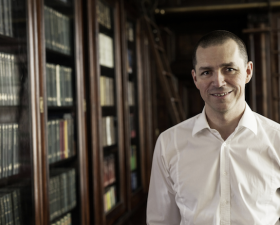Technologické centrum AV ČR, 11.10.2018.
Czech Liaison Office...
Dr. Lukáš Palatinus of the Institute of Physics of the Czech Academy of Sciences has won the 2017 Neuron Award for Promising Young Scientists in Physics. The award is granted by the Neuron Fund for Support of Science to Czech scientists under the age of 40 in recognition of their excellent research and results, and as an impetus for further work. Dr. Palatinus was honoured for his research in the methodology of structure analysis of aperiodic crystals and for the application of electron diffraction to the structure analysis of nanocrystals.
Dr. Palatinus graduated in Mineralogy and Geochemistry from the Faculty of Science, Charles University in Prague. Already in 1997, while in his third year of BA studies, he took part in the research of the group of Dr. Petříček and Dr. Dušek in the Department of Structure Analysis at the Institute of Physics. He earned his doctorate in 2003 at the University of Bayreuth under the supervision of Prof. Sander van Smaalen, and shortly after he started working as a postdoctoral researcher in the group of Prof. Gervais Chapuis at EPFL in Lausanne, Switzerland. Since his return to the Czech Republic in 2009, he has been working in the Department of Structure Analysis at the Institute of Physics of the Czech Academy of Sciences, where he currently leads the electron crystallography group.

At the beginning of his professional career, Dr. Palatinus worked on structure analysis of aperiodic crystals. During his doctoral studies, he completed and applied the method of maximum entropy for the determination of precise electron densities of aperiodic crystals. As a postdoctoral researcher in Lausanne, he explored the application of a novel crystal structure solution method - the charge flipping method - to periodic and aperiodic crystals and developed the program Superflip, which has been widely adopted by the crystallographic community and is one of the most commonly used programs in the field today. After his return to Prague, Dr. Palatinus has mostly focused on the structure analysis of nanocrystals. Since the standard X-ray structure analysis is not suitable for nanocrystals, he and his team started using an electron diffraction method. The group of Dr. Palatinus refined and developed this method in such a way that today it is possible to harvest precise structural information from nanocrystals with precision and reliability not achieved before. The method is so accurate that it can be used to detect the positions of even the lightest of all atoms – the hydrogens, as has been recently demonstrated in the paper of Dr. Palatinus et al. published in Science in its January 13th, 2017 issue.